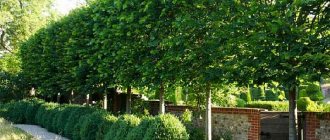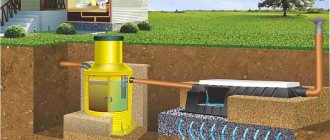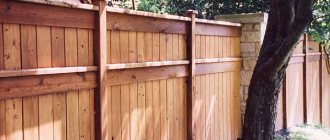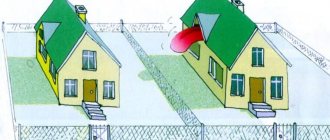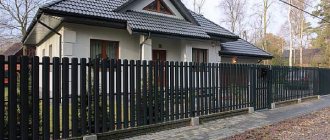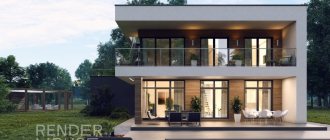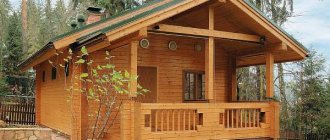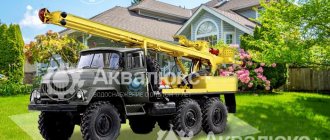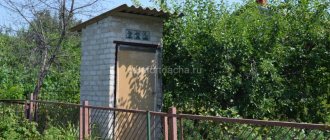The distance from trees to the fence is one of the norms provided by executive authorities and SNiP. They are known to any person who is closely involved in individual construction - the construction of his own permanent mansion or small country house. The standards included in SNiP (building codes and regulations) were first developed in 1974 and required strict compliance.
Example of non-compliance
Today, they all also relate to construction, architecture, buildings and structures, transport, roads, materials, even metro infrastructure. The developed standards also contain answers to seemingly simple questions. For example, at what distance from the fence can trees be planted, what should be the distance of each of them from the neighbor’s fence, residential building and outbuildings.
Other restrictions and requirements for tree planting
The minimum distance between a neighbor's fence and one of the large tree species is at least four meters. These crops include:
- various varieties of pears;
- apple trees;
- Oak trees;
- maple;
- coniferous species (including pine, spruce, cypress).
As for medium-sized trees, less stringent restrictions will apply. The distance between such varieties and the fencing of the neighboring plot should be no more than 2 meters. Such trees include:
- cherry;
- plum;
- sea buckthorn
- hazel
Often these crops do not exceed 10 meters in height, so they are considered safe for the neighboring area.
It happens that dwarf plant varieties are also planted in dacha areas. Traditionally, their height is 2-2.5 meters. For such crops, the minimum distance from bushes and the neighboring fence is only 1 meter. Plants of this type include:
- honeysuckle;
- bush raspberries;
- blackberries;
- black currant.
It is necessary to comply with planting standards, since this point is prescribed in the law. By violating it, you create a conflict, which entails a fine in an amount corresponding to the severity of the violation (the type of problems that were caused for non-compliance with SanPin standards).
A tree with a large root system will damage the hedge. Example of incorrect landing Source samstroy.com
Why do we need standards for planting trees from the fence?
Rules with required distances of trees and shrubs from the fence are needed for safety reasons. Plantings are not always used for decorative purposes. These can be large fruit plants with lush crowns. Such plants have a large root system; branches can overhang someone else's territory and disturb neighbors. Roots can damage communications. These standards were developed to preserve the integrity of the site. The distance between the wooden extension and the fence with plants must be maintained so that the roots do not damage the foundation of the attached object.
Large canopies can ruin a neighbor's crop. Excavation work makes it difficult for roots to feed on nutrients and soil. Therefore, other fastidious plants will not survive near demanding seedlings.
Types of discomfort that improperly planted houses can cause
Planted trees should bring joy to you, as the owner of the local area, but not cause discomfort to your neighbor. The problem may appear in a number of cases:
- the crown of the tree obscures light-loving crops in the neighboring area (thereby affecting the yield of a particular crop);
- the branches of your plant may litter the neighboring area with falling leaves;
- the greater power of the root system prevents neighboring plants from feeding and bearing fruit normally.
If such problems regularly arise, the neighbor has the right to independently cut off the interfering branches (even if there are fruits on them) or contact the administration (village council) to resolve the issue through legislative regulation.
Additional precautions
In the case of planting tall trees near the fence, it is necessary to discuss this issue with the neighbors. The owners of the second plot must sign a notarial agreement to issue consent for planting. This document will be valid even if the owners of the site change.
After the tree grows, the owner of the plot must take care that it does not throw needles or foliage onto the neighbor’s plot. If large branches hang over the neighboring area, then they must be removed.
What other restrictions are being considered?
SNiP, which regulates all standards regarding tree planting, has been registered since 1997 and today does not change its standards. Therefore, when planting, be sure to take into account the specifics of their growth.
How to correctly position the plant on the site in relation to the fence Source snt-veteran.rf
Accordingly, the standards must be taken into account not only regarding the distance to the neighboring fence, but also regarding other objects. Thus, it is worth paying attention to the following few points:
- the distance from large tree trunks to the fence is 4 meters;
- distance from poultry houses and outbuildings - 4 meters;
- distance from residential buildings - 3 meters;
- distance from trunks of medium-sized trees - 2 meters;
- distance from bushes - 1 meter.
The area of the current garden plots does not allow for wandering, so every centimeter has to be taken into account and the territory used sparingly. At the same time, it is impossible to plant trees randomly; this threatens a conflict in which plant crops will not be able to produce a good harvest.
On a note! If you plant tall trees on a site near houses, they can disrupt the functioning of communications: water supply and sewerage are deformed under the influence of the root system, and electricity due to contact with branches (threatens a short circuit).
Selecting the distance from green spaces to the road
This parameter is no less important and is also indicated in sanitary standards. For each landscaping object, the distance will be different, since it all depends on the height of the plant. For example, from a strip of shrub species to the road there should be 1.5 meters. If all these breeds are tall, then the distance should be at least 3 meters.
Norms for planting placement according to SNIP Source stroychik.ru
Generalized table
In order to plan planting, you can refer to the table reflecting the current law.
| An object | Distance (m) | |
| Up to the trees | To the bushes | |
| External walls of buildings | 5 | 1,5 |
| Base of retaining walls | 3 | 1 |
| Ditches and ditches | 2 | 1 |
| Paths | 0,7–1,5 | 0,5–0,7 |
| Fences and enclosures | 4, and in SNT – 3 | 1 |
| Highway | 2 | 1 |
| Power lines | 1,5–2 | – |
| Gas pipeline, sewerage | 1,5 | – |
| Water supply, heating networks | 2 | 1 |
| Power cable, communication | 2 | 0,7 |
Dispute Resolution: Details
As a rule, all issues, including the responsibility for growing green spaces on the territory of the local area, rest solely with the owner of the house. Therefore, everything related to violations and compensation for damage will directly affect the owner of the land.
The Land Code regulates the use of common land between two plots. More precisely, it states at what specific distance plantings are allowed between two adjacent plots (belonging to residential or gardening).
In case of violations, disputes often arise among neighbors about whose fruits are from the trees whose branches hang on the grid of the neighboring plot. As it turned out, if the problem cannot be resolved peacefully, then your neighbor can pick the fruits from your tree without your permission. Moreover, you will not be able to present anything, since you yourself are violating the requirements and standards regarding the distance of plantings in relation to someone else’s fence.
On a note! The court may make a decision in which, according to the law, the fruits from the tree that interferes with the neighbor are divided by gender. In case the plant is planted on the border between two plots, then the opposite owner has the right to demand that the plant be replanted.
Please note that if a tree from a neighboring plot hangs over the fence and interferes with the plants with its crown, then the owner of the adjacent territory has the right to cut off the branches or cut down the root system only if such circumstances caused damage to the crops growing on his plot: the fence was damaged, deformed outbuildings.
Otherwise, removing tree branches is prohibited. You will have to talk to the owner of the plant first if you are planning to plant seedlings or your own low-growing fruit crops in this place.
Distance from tree to fence Source zaborsebe.ru
Important to consider
In case disputes arise between neighbors regarding planted trees, shrubs and other vegetation, it is necessary to contact the local government in writing. It must indicate in detail the essence of the problem, be sure to include a date and signature.
The review will take several days (up to 10 days). After this, the authorities are obliged to go to the site and help the neighbors sort out the issues of the incorrectly planted plant. Please note that three days after the application, both parties to the conflict must receive a response in writing about the decision made. Also, each neighbor should be informed about the day the authorities will go to the site to solve the problem, and wait.
The outcome of the decision can be positive or negative. If the parties do not agree with the decision made, they have the right to go to court to re-decide the issue. Please note that local authorities have the right to ask to cut down a tree or dig up interfering bushes.
Distance between green spaces and communications: gas pipeline, water supply
This issue should not be ignored. After all, developing trees and other plantings can disrupt the integrity of the structure. These objects also have their own regulatory rules.
- If there is an underground gas pipeline or water supply on the site, then the distance from the tree should be at least 3 meters. This is due to the fact that during the development of the root system, integrity damage, water breakthrough or gas leakage are possible.
- In the case of ground communications, the following norm is adhered to: the distance should be equal to the height of the plants. That is, if you plant a tree that can reach a height of three meters, then the pipeline should be 3 meters from it.
Also, the listed rules apply to the sewerage system, septic tanks and common hatches located on the territory of a summer cottage or adjacent plot.
What can you plant in the shade? Flowers, vegetables, herbs
A logical question, after the above recommendations, will be “At what distance should I grow vegetables, herbs and flowers?” on a private plot. There are no regulatory recommendations for such vegetation, but you should know at what distance it is better to plant them from solar obstacles so that they can grow comfortably and have enough light.
Plants growing in the shade
You can plant only ornamental grass, moss and lawn grasses at a distance of several meters from structures and tall trees. It will be quite attractive, but not as beautiful as with flowers and not as rational as with vegetables and herbs.
In the shade or semi-shade areas, we recommend planting rhubarb, parsley, lettuce, red currants, peas, onions, garlic, beets, cauliflower, broccoli, beans, bush beans, horseradish, wild garlic, raspberries, radishes, herbs (thyme, parsley, tarragon, celery, lovage, cilantro, mint, oregano, lemon balm). Most of these vegetables and herbs are planted in early spring.
If there is no desire or need for harvesting and caring for it, then we suggest planting flowers on the remaining shady square meters. When choosing what and where to plant, consider the month of flowering and the color of the plants themselves. For ease of care, you can choose unpretentious perennials. These include: lilies of the valley, periwinkle, hosta (funkia), kupena, anemones, primroses, astilbes, aquilegia, bergenia, dicentra, doronicum (yellow chamomile), aruncus (volzhanka), forget-me-nots, elecampane, anemone, meadowsweet, meadowsweet, Rogers, aquilegia. If the sun has access to a shady area for at least 2-3 hours a day, then you can plant daylilies, phlox, aconite, peonies and irises.
Ground covers (juga, hoofweed, wild strawberries) and ferns will look beautiful in combination with flowers in the shade.
Reviews of conflict situations regarding green spaces
To make the situation clear, we suggest that you read reviews from real people who have encountered similar problems.
Marina, 46 years old, Voronezh
They say that ignorance of the law does not exempt you from responsibility. Unknowingly, I planted a tree right next to the neighbor’s fence. When the plant grew, it began to tear apart the fence mesh. The neighbor went to court without waiting for a decision from local authorities, without asking me. I won the case and a fine was collected from me.
Mikhail, 54 years old, Shchelkino
All our lives we lived amicably with our neighbors until they planted fruit trees right next to the fence - 40-50 cm from it. On my side of the plot there were strawberries growing, which began to die due to lack of sunlight. Local authorities forced neighbors to compensate for the damage and replant fruit crops.
Valentina, 49 years old, Pushkino
I bought a plot of land in a holiday village and planted trees, not knowing that there was a water supply running underground. 7 years later, the apricot roots violated its integrity, and there was a breakthrough. After that, I was forced to pay a fine and repair communications at my own expense.
